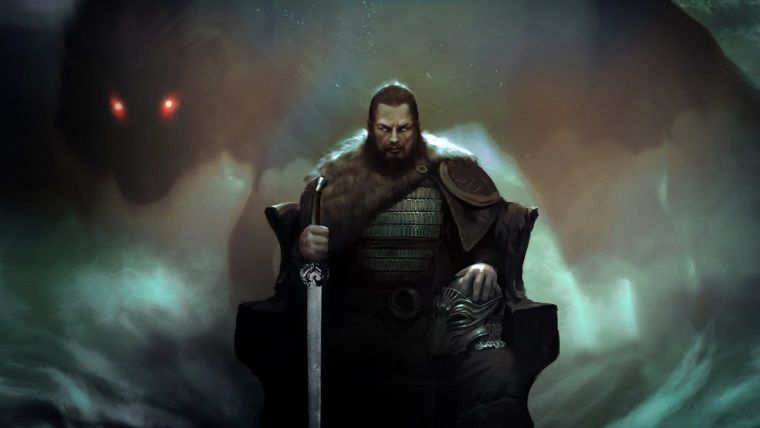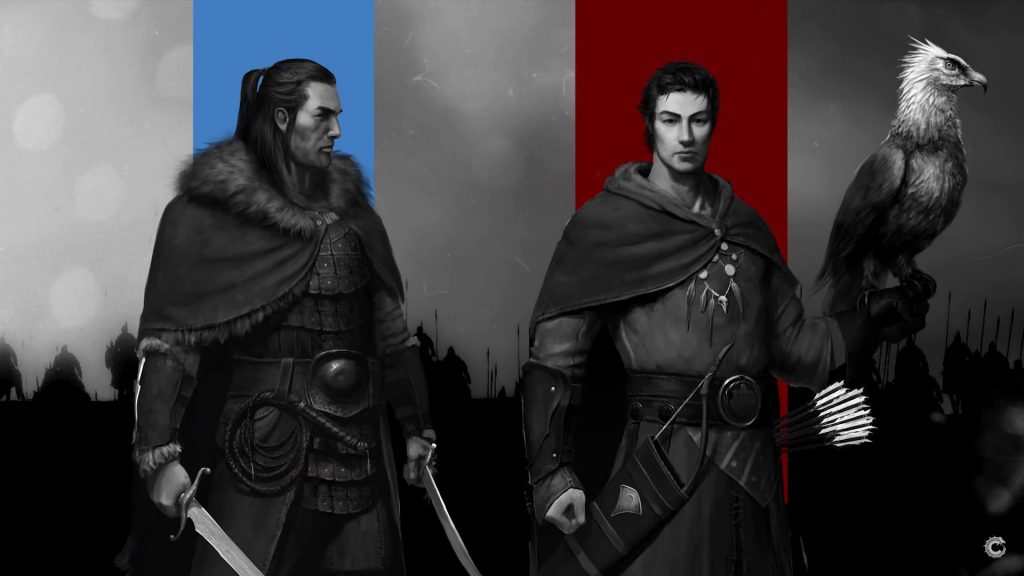Deleted
Deleted Member
Posts: 0
|
Post by Deleted on Mar 28, 2019 11:26:39 GMT -5
|
|
|
|
Post by charleshelm on Mar 28, 2019 19:48:32 GMT -5
Thank you sir. It did seem a bit preachy at times, but the scenery was spectacular and it was a look into the culture even if not 100 percent accurate.
|
|
Deleted
Deleted Member
Posts: 0
|
Post by Deleted on Mar 29, 2019 1:24:44 GMT -5
Thank you sir. It did seem a bit preachy at times, but the scenery was spectacular and it was a look into the culture even if not 100 percent accurate. Thanks Charleshelm. Yeah, the Altai mountains look spectacular. |
|
Deleted
Deleted Member
Posts: 0
|
Post by Deleted on Jun 10, 2019 13:35:40 GMT -5
Below you'll find some concept/pre-production art for the upcoming Göktürk Trilogy by Turkish filmmaker Alper Çağlar. Here's a breakdown of the trilogy, from what little information that I have managed to find so far. Ilk Göktürk (The First Göktürk) The story of the founders of the Göktürk Empire: The brothers Tumen (Bumin) Kaghan (title Illig Kaghan) and Istemi Kaghan. Kırk Göktürk (Forty Göktürks)The Göktürk Rebellion during the dark years of the interregnum (630-682AD). Son Göktürk (The Last Göktürk)Probably the story of Bilge Kaghan and his warrior brother Prince Kul (Kul Tigin).  By Batuhan Titiz.  Art by Ömer Tunç.  |
|
|
|
Post by kemp on Jun 10, 2019 20:04:42 GMT -5
Below you'll find some concept/pre-production art for the upcoming Göktürk Trilogy by Turkish filmmaker Alper Çağlar. Here's a breakdown of the trilogy, from what little information that I have managed to find so far. Ilk Göktürk (The First Göktürk) The story of the founders of the Göktürk Empire: The brothers Tumen (Bumin) Kaghan (title Illig Kaghan) and Istemi Kaghan. Kırk Göktürk (Forty Göktürks)The Göktürk Rebellion during the dark years of the interregnum (630-682AD). Son Göktürk (The Last Göktürk)Probably the story of Bilge Kaghan and his warrior brother Prince Kul (Kul Tigin).  By Batuhan Titiz.  Art by Ömer Tunç.  Cool art. Tengri would be pleased. |
|
Deleted
Deleted Member
Posts: 0
|
Post by Deleted on Jun 18, 2019 0:47:45 GMT -5
Here's another intriguing Historical Documentary by TRT all about the Battle of Malazgirt (Manzikert) in 1071 between the Turkic hordes of Alpaslan the Sultan of the Seljuks and the Byzantine Emperor Romanos Diogenes. Thankfully, like the Cossack video we have subs in English. Legends of War - Episode 1| The Battle of Manzikert
Wikipedia link: en.wikipedia.org/wiki/Battle_of_Manzikert#Battle |
|
Deleted
Deleted Member
Posts: 0
|
Post by Deleted on Jun 19, 2019 15:54:54 GMT -5
 The Fight of the Stallions (1958) by Mongolian artist Ochir Tsevegjav (1915-1975) |
|
|
|
Post by kemp on Jun 20, 2019 9:25:01 GMT -5
The successful Turkish tribal leader Osman I ( Othman ) was the founder of the Ottoman dynasty. Ottoman tradition describes Osman’s ancestors as hailing from the Kay tribe of the central Asian Oghuz Turks. The Sword of Osman was an important sword of state used during the enthronement of the Turkish Sultans.  The Ottoman Empire at its height was impressive, especially at its peak under Suleiman the Magnificent, covering the whole of the Balkans and parts of central and eastern Europe, Anatolia , the fertile crescent area of the middle east including the southern parts of Iraq, parts of Saudi Arabia and the Mediterranean regions of the North Africa.  Ottoman corsairs ( also as Barbary pirates) operated throughout the Mediterranean, south along West Africa’s Atlantic seaboard and into the North Atlantic as far north as Iceland were they took hundreds of Icelanders as slaves in the 1600’s. |
|
|
|
Post by kemp on Jun 29, 2019 8:00:30 GMT -5
The earliest phase of the Ottoman military was based on a steppe nomadic cavalry force, notably in the Osman phase where there was still some connection and influence from the Turkoman tribesman of the 13th century. The Ottoman army became a standing army by the time of Mehmed II, still maintained cavalry divisions, but supplemented by infantry units such as the Janissaries, an elite infantry unit made up of recruited Europeans formerly taken as slaves.  Interesting to note that the steppe people that moved west into Europe lost or abandoned some of their nomadic steppe fighting abilities or supplemented them with new tactics picked up on the plains and valleys of Europe. This was true of the Bulgars and Magyars of the early middle ages. Gradually, the infantry formed a main part of the fighting force, although cavalry still played an important role, the famed Hungarian hussars for example.  |
|
Deleted
Deleted Member
Posts: 0
|
Post by Deleted on Jul 14, 2019 2:45:35 GMT -5
Here's the trailer to the Sakha Movie based on Beyberikeen.
I have not been able to acquire any information concerning the Sakha Legend of Beyberikeen - nevertheless, it looks fascinating.
Beyberikeen Trailer
Kııstaah uol preformed by Dalaana (Beyberikeen theme tune)
|
|
Deleted
Deleted Member
Posts: 0
|
Post by Deleted on Jul 26, 2019 10:12:51 GMT -5
Here's a trailer for the upcoming Kazakh movie based on the life of the great Amazonian warrior Tomiris (fortunately with English subtitles)
|
|
Deleted
Deleted Member
Posts: 0
|
Post by Deleted on Aug 4, 2019 13:03:06 GMT -5
 Kazakh Eagle (Berkütchi) hunters of Xinjiang, China. |
|
Deleted
Deleted Member
Posts: 0
|
Post by Deleted on Aug 12, 2019 1:35:12 GMT -5
Lost Sogdian Art in China
voicesoncentralasia.org/lost-sogdian-art-in-china/Little is known of the lives of Sogdians in China, even though the Chinese connections of Sogdian elites played an important political, economic, and cultural role in the lives of people in the region at the time.
Before the Arab invasion, Sogdians were known traders who benefitted from bringing Chinese luxury goods to Iran, Turkic tribes, and others in their region. As historian Richard Foltz writes, Sogdians maintained permanent neighborhoods in Chinese cities, enjoyed the favor of Chinese rulers, were extremely wealthy, and lived an elegant life in both China and Sogd. Sogdians were well-known in China, not only for their talent in commerce, but also for their music, dances, and art.Sogdian art in China is a research focus of Professor Jin Xu of Vassar College, a private liberal arts college in New York, who shed some light on this page of the history:– I have been obsessed with Sogdian art since I was a college student almost twenty years ago. At the time, Chinese archaeologists had just uncovered a series of sarcophagi, stone coffins, and funerary couches that had been owned by Sogdian immigrants in North China during the sixth century AD. The wonderfully decorated stones were accompanied by epitaphs about the lives of their deceased owners, telling us where they came from, why they moved to China, and what they achieved as immigrants. These sarcophagi made it possible for scholars to think about Sogdian art in the context of Chinese culture; they also opened the door to Sogdian art for me. Wirkak or Shi Jun Sarcophagus. 580 AD. Xi’an, Shaanxi Province. Wirkak or Shi Jun Sarcophagus. 580 AD. Xi’an, Shaanxi Province.
|
|
Deleted
Deleted Member
Posts: 0
|
Post by Deleted on Aug 12, 2019 1:40:53 GMT -5
In Search of Traces of Sogdian Art in China
Sogdian people moved to China for several reasons. Trade was a major reason, but it was not the only one. Sogdian monks, for example, were among the first Buddhist missionaries to spread the teachings of the Buddha in China. Beginning in the mid-sixth century, Chinese rulers increasingly began to depend on Sogdian elites to handle diplomatic, commercial, military, and even cultural issues; this inspired many Sogdians to migrate from Central Asia and the Chinese borderlands to political centers in China, such as Luoyang, Chang’an, and Ye. Ceramic Jar with Sogdian Musicians and Dancer. 6th Century AD. Anyang, Henan Province (Photo by Laozhu de suisuinian)In the seventh century, when the Tang emperors defeated the Turkic Empire on the Mogul grassland, Sogdian elites who had previously worked for the Turks adjusted their loyalties and relocated to China. But not all Sogdian immigrants in China were from wealthy or elite backgrounds. Many Sogdian immigrants made a living in China as peasants, entertainers, dancers, and servants. Ceramic Jar with Sogdian Musicians and Dancer. 6th Century AD. Anyang, Henan Province (Photo by Laozhu de suisuinian)In the seventh century, when the Tang emperors defeated the Turkic Empire on the Mogul grassland, Sogdian elites who had previously worked for the Turks adjusted their loyalties and relocated to China. But not all Sogdian immigrants in China were from wealthy or elite backgrounds. Many Sogdian immigrants made a living in China as peasants, entertainers, dancers, and servants.
Sogdian art in China encompasses almost all of the major categories of art in Medieval China (220-906 AD): textiles, stone and jade carving, architecture, painting, dance, music, performances, etc.
Sogdian artists were instrumental in making Chinese imperial art, previously quite Sino-centric, more diverse and cosmopolitan toward the end of the sixth century. Chinese art is so rich and has so many different faces because it has never stopped absorbing styles, motifs, and techniques of non-Chinese origin throughout its long history. Sogdian art in China provides one of the most illuminating examples of this dynamic. Sogdian art brought together a wide range of artistic traditions from along the Silk Road. Most importantly, it made a decisive contribution to the birth of the art of the Sui and Tang dynasties (581-907 AD), a period widely regarded as the golden age of Chinese civilization.
One of the known Sogdian representatives of this period is a third-generation Sogdian immigrant called He Chou (ca. 543-622 AD). He Chou was appointed head of the imperial workshop by Chinese emperors; in that role, he reshaped imperial art with his profound knowledge of both Chinese and Sogdian art traditions. Brocade with Lion Hunting. Attributed to He Chou (ca. 543-622 AD). Horyuji Temple. Nara, Japan.Strictly speaking, “Sogdian art in China” refers to the art and architecture created by Sogdian artists and artisans living in the territories of the Chinese dynasties that existed between the sixth and tenth centuries. However, many Sogdian artists and their families lived in China for several generations, and they often commissioned or collaborated with Chinese artists to carry out their art projects. For these reasons, “Sino-Sogdian art” may be the more accurate term here. Brocade with Lion Hunting. Attributed to He Chou (ca. 543-622 AD). Horyuji Temple. Nara, Japan.Strictly speaking, “Sogdian art in China” refers to the art and architecture created by Sogdian artists and artisans living in the territories of the Chinese dynasties that existed between the sixth and tenth centuries. However, many Sogdian artists and their families lived in China for several generations, and they often commissioned or collaborated with Chinese artists to carry out their art projects. For these reasons, “Sino-Sogdian art” may be the more accurate term here.
Sogdian art also had a significant impact on paintings within elite circles. A Sogdian painter called Cao Zhongda established a unique style or school that was named after him. This so-called “Cao Family Style” would become one of the most celebrated styles in the entire history of Chinese painting.
I have been discussing how Sogdian art would have appeared to some elites, but to most Chinese people, Sogdian art looked strange, exotic, and mysterious. Evidence of this is provided by the exaggerated, cartoonish representations of Sogdians and their belongings created by Chinese artists in the sixth and seventh centuries. It is likely that a considerable amount of Sogdian art, particularly those artifacts associated with Sogdian religious beliefs, was produced exclusively for the Sogdian immigrant population, and not for Chinese audiences.
|
|
Deleted
Deleted Member
Posts: 0
|
Post by Deleted on Aug 12, 2019 1:46:59 GMT -5
Influence of Religion
The advent of Sogdian arts in China was intimately related to Buddhism, which many Sogdian immigrants practiced. Sogdians commissioned Buddhist cave chapels and statues; the designs often incorporated Sasanian Persian and Central Asian motifs that reflected the identities of their sponsors. Professor Annette Juliano has pointed out the abundant Buddhist elements in Sogdian arts made in China, which can be found not only in depictions of individual subjects but also in the ways in which landscape and architecture were represented. Banquet in Paradise after Buddhist Models. Yu Hong Sarcophagus. 592 AD. Taiyuan, Shanxi Province.In fact, the aforementioned Sogdian painter Cao Zhongda was best known for his Buddhist paintings. As my research demonstrates, on the sarcophagus of Wirkak, the leader of a Sogdian community, a pictorial biography of the dead was even constructed that was analogous to the illustrated life of Prince Siddhartha, later to become the Buddha. Banquet in Paradise after Buddhist Models. Yu Hong Sarcophagus. 592 AD. Taiyuan, Shanxi Province.In fact, the aforementioned Sogdian painter Cao Zhongda was best known for his Buddhist paintings. As my research demonstrates, on the sarcophagus of Wirkak, the leader of a Sogdian community, a pictorial biography of the dead was even constructed that was analogous to the illustrated life of Prince Siddhartha, later to become the Buddha.
Sogdian artists in China were well-versed in both Sogdian and Chinese artistic traditions; consequently, it comes as little surprise that they were able to merge the two to produce something entirely new and innovative. Ascension to Heaven. Wirkak Sarcophagus. 580 AD. Xi’an, Shaanxi Province.For example, the Zoroastrian iconography that appears on artifacts created by Sogdians living in China looks quite different from the Zoroastrian iconography we see in Central Asia and Persia. Ascension to heaven, a subject seldom seen in orthodox Zoroastrian art, is common on the sarcophagi of Sogdian immigrants in China. Sometimes, this subject is even illustrated in such a detailed manner as to depict the ascension in multiple stages, beginning with the funeral and the crossing of the bridge that separates life and death, and concluding with the judgment of the soul and its eventual arrival in paradise. Such meticulous representations of the afterlife reflect the influence of the tradition of tomb art in China, which can be traced back to the time when the famous terracotta soldiers of the First Emperor (259 –210 BC) were produced. Ascension to Heaven. Wirkak Sarcophagus. 580 AD. Xi’an, Shaanxi Province.For example, the Zoroastrian iconography that appears on artifacts created by Sogdians living in China looks quite different from the Zoroastrian iconography we see in Central Asia and Persia. Ascension to heaven, a subject seldom seen in orthodox Zoroastrian art, is common on the sarcophagi of Sogdian immigrants in China. Sometimes, this subject is even illustrated in such a detailed manner as to depict the ascension in multiple stages, beginning with the funeral and the crossing of the bridge that separates life and death, and concluding with the judgment of the soul and its eventual arrival in paradise. Such meticulous representations of the afterlife reflect the influence of the tradition of tomb art in China, which can be traced back to the time when the famous terracotta soldiers of the First Emperor (259 –210 BC) were produced.
After the mid-seventh century, when Islam became the dominant religion in the Sogdian homeland and the An Lushan rebellion brought the heyday of the Tang dynasty to an end, Sogdian art began to develop very differently in China from in Central Asia. In Central Asia, Sogdian art was absorbed into the Islamic visual culture that was emerging at that time.
In China, after the rebellion of An Lushan, a Chinese general of Turkic-Sogdian origin, Chinese rulers and elites became hostile to foreign elements in Chinese art and culture, including those associated with Sogdians. Sogdian art lost the popularity and prestige it had previously enjoyed. Sogdians became the scapegoats for the decline of the Tang dynasty; Sogdian arts came to be seen as disgraceful and decadent. Both Chinese and Sogdian artists went to great lengths to get rid of any signs of Sogdian influence in their works. By the eleventh century, while many descendants of Sogdians still lived in China, you would probably not have been able to tell their art apart from that of their Chinese counterparts. Mi Fu, one of the most acclaimed calligraphers and painters in Chinese history, who was active in the eleventh century, is believed to have been of Sogdian origin. But Mi Fu’s art cannot even remotely be compared to the Sogdian art we know from early periods. Mi Fu (1051–1107), “Auspicious Pines in Spring Mountains.” National Palace Museum, Taipei. Mi Fu (1051–1107), “Auspicious Pines in Spring Mountains.” National Palace Museum, Taipei.
|
|